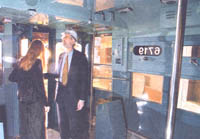
Smithsonian officials tour CTA car no. 6719, which will be a major part of the Museum of American History's transportation exhibit. For a larger view, click here. (Tribune photo by Pete Souza)
The CTA's car No. 6719, which carried riders around the Loop and beyond for 33 years, will be a key component of an exhibit on transportation
By Michael Kilian
Washington Bureau
Date of Publication: January 9, 2003
Source: Chicago
Tribune
WASHINGTON -- It may have seemed just another Chicago Transit Authority car to the long-suffering riders who used it between 1959 and 1992, but on Wednesday Mass Transit Car No. 6719 became enshrined as part of the nation's history.
The Smithsonian Institution in Washington officially installed the car as a centerpiece of its new "America On the Move" permanent transportation exhibition, to open in November at the National Museum of American History.
 Smithsonian officials tour CTA car no. 6719, which will be a major part of the Museum of American History's transportation exhibit. For a larger view, click here. (Tribune photo by Pete Souza) |
But to the Smithsonian, the car deserved a place in the historic museum collection that includes the original Star-Spangled Banner, George Washington's military tent and Dolley Madison's dancing slippers.
"It symbolizes the way many people got around and lived their lives in the last half of the 20th Century," said exhibition curator Bonnie Lilienfeld.
There's another reason for No. 6719's coming to the Smithsonian: In fine Chicago tradition, it has "connections." Lilienfeld is a former Chicagoan and University of Chicago graduate who lobbied for the city to play a big part in the $22 million, 26,000-square-foot exhibition.
She was already working with the CTA on acquiring a major portion of the old Madison-Wabash elevated station for display in the show when she heard that the system was selling five of its transit cars for salvage. In a quick deal, No. 6719 was spared the scrap heap and headed toward posterity.
"You can't have an exhibition on transportation in the 20th Century without Chicago being a big part of it," said William Withuhn, the museum's chief transportation curator.
The concept of the exhibition is to follow the development of transportation and living patterns by focusing on different locations at different times. The late 19th Century is represented by an 1876 locomotive from the first rail network in California; New York is shown as a major harbor in the 1920s.
According to Lilienfeld, the Chicago area was picked to represent the post-World War II boom in transport and urban and suburban development because the region's growth was generated by many forms of transportation.
Chicago's huge share of the new exhibition will include not only the reconstruction of a Loop "L" station and train, but also a replicated section of suburban Park Forest in the 1950s. The exhibit also will explore the decision of the late Mayor Richard J. Daley to expand the military's O'Hare Field into a major commercial airport.
The Madison-Wabash elevated station will be reconstructed with sections of the original and furnished with signs and advertisements from the period. A platform beside No. 6719 will allow museum visitors to enter the car in the manner of the riders of yore.
The car was used mostly on the Ravenswood Line, now known as the Brown Line, but eventually worked the entire CTA system. It has been painted its original 1959 colors: Swamp Holly Orange, Croydon Cream and Mercury Green.
Once aboard, visitors will be able to "ride" the CTA system through the use of video projections at the windows and special effects that will make the car sway, rattle and screech as in real life. Vintage ads from 1959 will be installed in the car, though there will be none for liquor or tobacco, Lilienfeld said.
She said there will be no wads of chewing gum, either, but there will be passengers in the form of talking mannequins, who will "speak" by means of recordings about shopping and exciting new developments in the Chicago area, circa 1959.
|
|